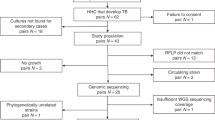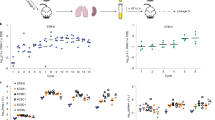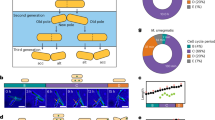Abstract
Few tools exist to assess replication of chronic pathogens during infection. This has been a considerable barrier to understanding latent tuberculosis, and efforts to develop new therapies generally assume that the bacteria are very slowly replicating or nonreplicating during latency1,2,3. To monitor Mycobacterium tuberculosis replication within hosts, we exploit an unstable plasmid that is lost at a steady, quantifiable rate from dividing cells in the absence of antibiotic selection. By applying a mathematical model, we calculate bacterial growth and death rates during infection of mice. We show that during chronic infection, the cumulative bacterial burden—enumerating total live, dead and removed organisms encountered by the mouse lung—is substantially higher than estimates from colony-forming units. Our data show that M. tuberculosis replicates throughout the course of chronic infection of mice and is restrained by the host immune system. This approach may also shed light on the replication dynamics of other chronic pathogens.
This is a preview of subscription content, access via your institution
Access options
Subscribe to this journal
Receive 12 print issues and online access
$209.00 per year
only $17.42 per issue
Buy this article
- Purchase on SpringerLink
- Instant access to full article PDF
Prices may be subject to local taxes which are calculated during checkout



Similar content being viewed by others
References
Warner, D.F. & Mizrahi, V. Tuberculosis chemotherapy: the influence of bacillary stress and damage response pathways on drug efficacy. Clin. Microbiol. Rev. 19, 558–570 (2006).
Cho, S.H. et al. Low-oxygen-recovery assay for high-throughput screening of compounds against nonreplicating Mycobacterium tuberculosis. Antimicrob. Agents Chemother. 51, 1380–1385 (2007).
Lenaerts, A.J. et al. Preclinical testing of the nitroimidazopyran PA-824 for activity against Mycobacterium tuberculosis in a series of in vitro and in vivo models. Antimicrob. Agents Chemother. 49, 2294–2301 (2005).
Frieden, T.R., Sterling, T.R., Munsiff, S.S., Watt, C.J. & Dye, C. Tuberculosis. Lancet 362, 887–899 (2003).
Wayne, L.G. & Sohaskey, C.D. Nonreplicating persistence of Mycobacterium tuberculosis. Annu. Rev. Microbiol. 55, 139–163 (2001).
Harries, A.D. & Dye, C. Tuberculosis. Ann. Trop. Med. Parasitol. 100, 415–431 (2006).
Lewis, K.N. et al. Deletion of RD1 from Mycobacterium tuberculosis mimics bacille Calmette-Guerin attenuation. J. Infect. Dis. 187, 117–123 (2003).
Lazarevic, V., Nolt, D. & Flynn, J.L. Long-term control of Mycobacterium tuberculosis infection is mediated by dynamic immune responses. J. Immunol. 175, 1107–1117 (2005).
Rees, R.J.M. & Hart, P.D. Analysis of the host-parasite equilibrium in chronic murine tuberculosis by total and viable bacillary counts. Br. J. Exp. Pathol. 42, 83–88 (1961).
Munoz-Elias, E.J. et al. Replication dynamics of Mycobacterium tuberculosis in chronically infected mice. Infect. Immun. 73, 546–551 (2005).
Cosma, C.L., Humbert, O. & Ramakrishnan, L. Superinfecting mycobacteria home to established tuberculous granulomas. Nat. Immunol. 5, 828–835 (2004).
Meijer, A.H. et al. Identification and real-time imaging of a myc-expressing neutrophil population involved in inflammation and mycobacterial granuloma formation in zebrafish. Dev. Comp. Immunol. 32, 36–49 (2008).
Swaim, L.E. et al. Mycobacterium marinum infection of adult zebrafish causes caseating granulomatous tuberculosis and is moderated by adaptive immunity. Infect. Immun. 74, 6108–6117 (2006).
Comstock, G.W., Baum, C. & Snider, D.E. Isoniazid prophylaxis among alaskan eskimos: a final report of the Bethel isoniazid studies. Am. Rev. Respir. Dis. 119, 827–830 (1979).
American Thoracic Society & Centers for Disease Control and Prevention. Supplement—American Thoracic Society Centers for Disease Control and Prevention Targeted tuberculin testing and treatment of latent tuberculosis infection. Am. J. Respir. Crit. Care Med. 161, S221–S247 (2000).
Stover, C.K. et al. A small-molecule nitroimidazopyran drug candidate for the treatment of tuberculosis. Nature 405, 962–966 (2000).
Kanai, K. Experimental studies on host-parasite equilibrium in tuberculous infection, in relation to vaccination and chemotherapy. Jpn. J. Med. Sci. Biol. 19, 181–199 (1966).
Keane, J. TNF-blocking agents and tuberculosis: new drugs illuminate an old topic. Rheumatology (Oxford) 44, 714–720 (2005).
Bachrach, G. et al. A new single-copy mycobacterial plasmid, pMF1, from Mycobacterium fortuitum which is compatible with the pAL5000 replicon. Microbiology 146, 297–303 (2000).
Zambrano, M.M., Siegele, D.A., Almiron, M., Tormo, A. & Kolter, R. Microbial competition: Escherichia coli mutants that take over stationary phase cultures. Science 259, 1757–1760 (1993).
Smeulders, M.J., Keer, J., Speight, R.A. & Williams, H.D. Adaptation of Mycobacterium smegmatis to stationary phase. J. Bacteriol. 181, 270–283 (1999).
Davison, A.C. & Hinkley, D.V. Bootstrap Methods and Their Application, Chs. 2 and 4 (Cambridge University Press, Cambridge, 1997).
Rhoades, E.R., Frank, A.A. & Orme, I.M. Progression of chronic pulmonary tuberculosis in mice aerogenically infected with virulent Mycobacterium tuberculosis. Tuber. Lung Dis. 78, 57–66 (1997).
Mogues, T., Goodrich, M.E., Ryan, L., LaCourse, R. & North, R.J. The relative importance of T cell subsets in immunity and immunopathology of airborne Mycobacterium tuberculosis infection in mice. J. Exp. Med. 193, 271–280 (2001).
Rivas-Santiago, B. et al. β-defensin gene expression during the course of experimental tuberculosis infection. J. Infect. Dis. 194, 697–701 (2006).
Nuermberger, E. et al. Rifapentine, moxifloxacin or DNA vaccine improves treatment of latent tuberculosis in a mouse model. Am. J. Respir. Crit. Care Med. 172, 1452–1456 (2005).
Aly, S. et al. Oxygen status of lung granulomas in Mycobacterium tuberculosis–infected mice. J. Pathol. 210, 298–305 (2006).
Tsai, M.C. et al. Characterization of the tuberculous granuloma in murine and human lungs: cellular composition and relative tissue oxygen tension. Cell. Microbiol. 8, 218–232 (2006).
Via, L.E. et al. Tuberculous granulomas are hypoxic in guinea pigs, rabbits and nonhuman primates. Infect. Immun. 76, 2333–2340 (2008).
Wards, B.J. & Collins, D.M. Electroporation at elevated temperatures substantially improves transformation efficiency of slow-growing mycobacteria. FEMS Microbiol. Lett. 145, 101–105 (1996).
Park, H.D. et al. Rv3133c/dosR is a transcription factor that mediates the hypoxic response of Mycobacterium tuberculosis. Mol. Microbiol. 48, 833–843 (2003).
Rustad, T.R., Harrell, M.I., Liao, R. & Sherman, D.R. The enduring hypoxic response of Mycobacterium tuberculosis. PLoS ONE 3, e1502 (2008).
Acknowledgements
We would like to thank L. Ramakrishnan, J. Chang, K. Guinn, T. Walker and members of the Sherman lab for review of and contributions to this work, C. DeMille for expert help with manuscript preparation and K.G. Papavinasasundaram (University of Massachusetts Medical School) for providing pBP10. This research was supported by grants from the US National Institutes of Health and the Paul G. Allen Family Foundation.
Author information
Authors and Affiliations
Contributions
W.P.G., N.S.H., M.R.W., R.P.L. and D.R.S. designed all experiments. W.P.G., N.S.H., R.P.L. and M.R.W. performed all experiments. W.P.G., N.S.H., M.R.W., J.E.M. and D.R.S. analyzed the data. J.E.M. derived the equations in consultation with W.P.G., and D.R.S. W.P.G. and D.R.S. wrote the paper, which was edited by all authors.
Corresponding author
Supplementary information
Supplementary Text and Figures
Supplementary Methods, Supplementary Fig.1 and Supplementary Equations 1 and 2 (PDF 364 kb)
Rights and permissions
About this article
Cite this article
Gill, W., Harik, N., Whiddon, M. et al. A replication clock for Mycobacterium tuberculosis. Nat Med 15, 211–214 (2009). https://doi.org/10.1038/nm.1915
Received:
Accepted:
Published:
Issue Date:
DOI: https://doi.org/10.1038/nm.1915



